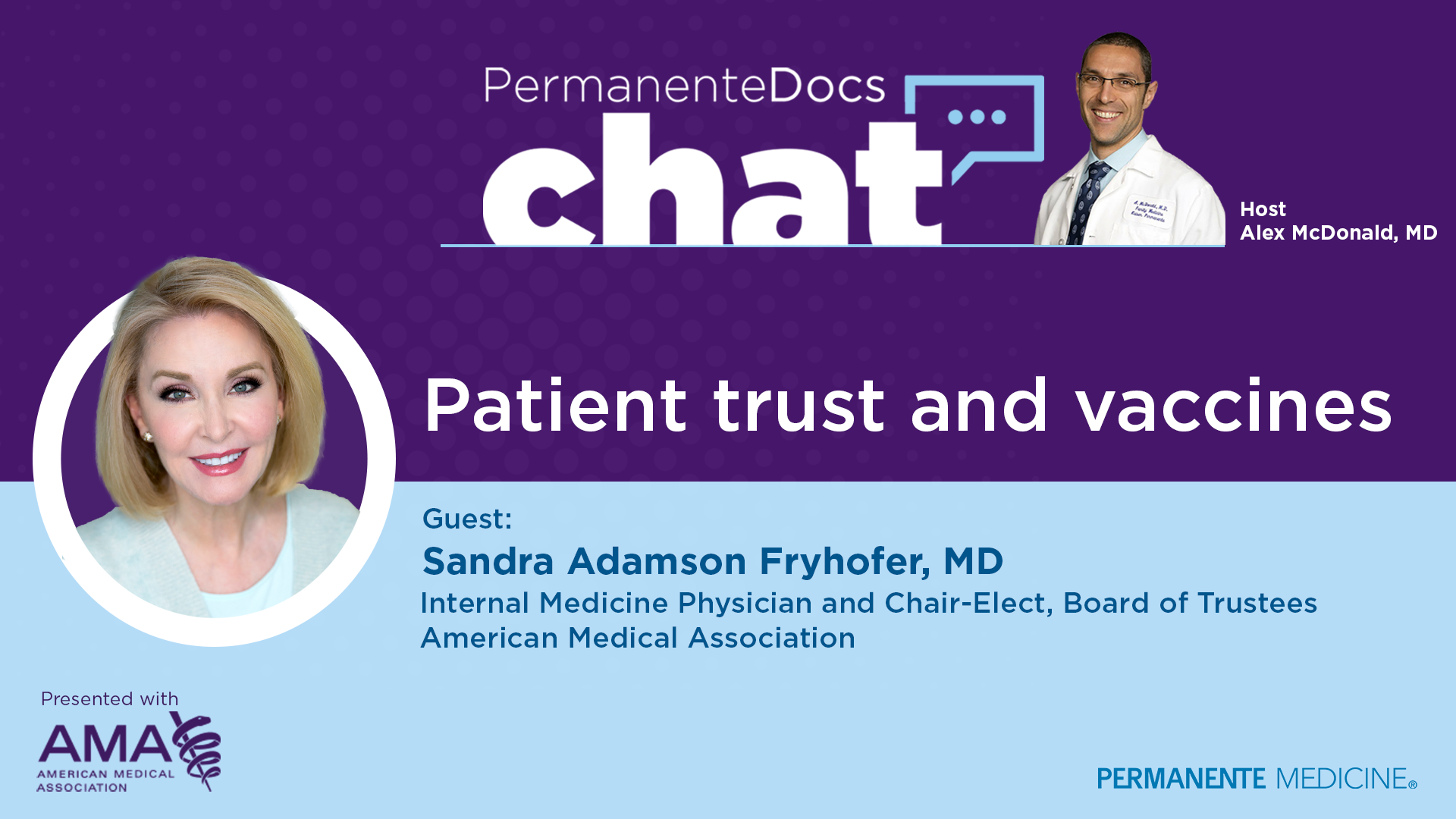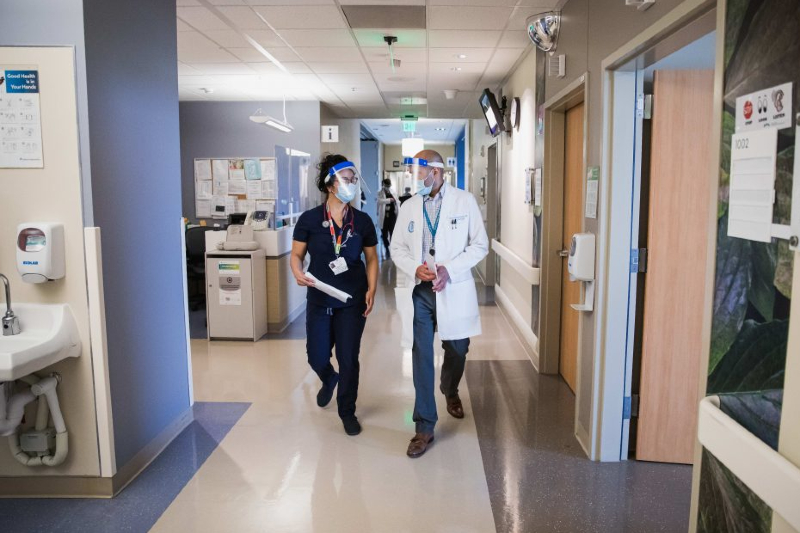PermanenteDocs Chat podcast on flu, COVID, and RSV vaccine safety and effectiveness updates with Sandra Fryhofer, MD, of the American Medical Association.

Pediatricians at Kaiser Permanente find advantages to video visits
A transition accelerated by a pandemic could permanently shift more care delivery to ‘patients’ turf’
By Jan Greene
Senior Communications Consultant
Parents, children, and pediatricians with Kaiser Permanente Northern California (KPNC) have found advantages to home-based video medical visits, which have increased markedly since the beginning of the COVID-19 pandemic, write 3 physicians in a Nov. 2 editorial in JAMA Pediatrics.

The trio, led by Kaiser Permanente Division of Research Director Tracy Lieu, MD, MPH, describe what they’ve learned in this transition for about 850,000 children who are Kaiser Permanente members in Northern California. “Our rapid learning curve in providing video care has been really impressive,” says Dr. Lieu, also a practicing pediatrician with The Permanente Medical Group (TPMG). “As a pediatrician, I feel very fortunate to be part of a medical group that’s been so proactive about helping our physicians and patients into this new era.”
When Northern California’s shelter-in-place orders began in March 2020, TPMG’s physicians realized that the new normal for many doctor appointments, including pediatrics, would be virtual. Physicians and medical staff were trained to use the video care option. The authors note benefits for families, including not having to cajole children into a trip to the doctor, find parking, and mingle with potentially ill children in the waiting room.
Two of the editorial’s authors — Elio Gizzi, MD, a Richmond-based TPMG pediatrician, and Edward Lee, MD, a TPMG associate executive director and chief information officer of The Permanente Federation — discuss what this seismic shift in technology means for doctors and their young patients.
Q: How is the transition to video visits with children and families going overall?

Dr. Gizzi: It’s been a learning experience for all parties. We’ve done telephone visits for a long time and most people are comfortable speaking on the phone — we’re really good at telephone assessments.
The video component adds a whole new level of complexity. We’re getting good at it though. We now are doing something called “virtual rooming,” where the support staff starts the remote visit with the patient to assure a smooth technological connection, and the doctor then joins. It’s made most of us not fear video visits and actually look forward to them.
It’s also nice to see our patients’ whole faces. When they are here in the office, they’re usually wearing masks.
Q: How do the various ages of young people react to being on camera?
Dr. Gizzi: In pediatrics, some video visits don’t involve the children, it’s just the parent because there’s a specific topic to discuss, such as sleep or stress issues for their children.
For newborns, we’ve found some real value in video for lactation support for families. Video visits also can be a great option for some newborns as long as there’s a scale at home for the baby so we can track growth. Toddlers can be a little bit more challenging because they may not be as cooperative on video, though we can definitely observe something the parent is concerned about. School-aged kids are much more cooperative and will share their histories.
We’ve discovered that teenagers can be very effectively seen by video. In fact, when teens are in a confidential space in their own home, they are often more open with us.

Q: What about families that may have technical or other barriers to video care?
Dr. Lee: We recognize this as an issue, yet access to technology continues to improve. We have also embarked on some pilot projects to bring the technology to our patients. We’re doing this now in the adult population, but we could certainly consider doing this for our pediatric patients. We provide a cellular-enabled iPad for patients who don’t have smartphones or computers. Our clinicians can also use opportunities when they interact with patients to get them set up technologically in anticipation of a future video visit.
Q: What have you learned about your patients and families by seeing their homes?
Dr. Gizzi: What their homes look like, what level of chaos might be going on, whether they have pets, for example. I learned that one parent I’ve known for a long time was an amazing artist; he took me on a tour of his house showing me all his paintings. That’s now part of my core connection with him.
Kids may be more relaxed at home. I had a checkup with a 5-year-old girl, her mom, and their new dog. I asked the girl to share with me something she had learned recently or was proud of. She whispered in her mom’s ear for permission and then proceeded to burp the alphabet at me while the dog barked hysterically. I responded by burping back “thank you.” That would never have happened in the office.
There is something about the power-sharing aspect of video where they’ve invited us into their homes; there’s something deep going on in that type of connection that we don’t get in the office, honestly, because they’re always on our turf in the office. With video we’re on their turf.
Q: You say that future pediatric care is likely to involve a combination of phone, video, email, and in-person care. How can clinicians know which to use, and when?
Dr. Gizzi: I think there’s going to be a shift in what parents and physicians see as normal types of communication for particular type of visits or needs. We’ll see video as one of the normal ways you interact with your pediatrician.
Dr. Lee: All these different telehealth modalities are tools that our physicians can use to deliver care. We’ve also started using devices that will enable us to remotely listen to a patient’s heart or lungs and look in their ears or mouth. We will be able to do even more with remote diagnostic devices in the future. For now, we are still in the process of learning what is the best tool to use and in what situation, and it’s great to have these different options available.
Jan Greene is a senior communications consultant with the Kaiser Permanente Division of Research in Northern California. This article was originally published on the Division of Research website.

